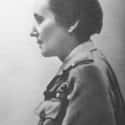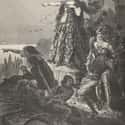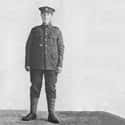-
(#13) Wanda Gertz, The Woman Who Fought In Three Wars
Wanda Gertz was a titan among women who witnessed, experienced, and played a part in 20-century history. Born in 1896, Gertz began life in Warsaw, Poland, in a family of Saxon heritage. In 1914, Wanda was part of a nationalist independence organization, Konfederacji Polskiej (KP) and helped equip the Warsaw Battalion to fight in WWI. At the time, women were barred from serving, but this didn’t discourage Wanda, and she decided to disguise herself as a man by the name of Kazimierz Żuchowicz.
Soon, Wanda saw combat on the eastern front of WWI in conflicts against the Imperial Russian Army. While campaigning, she developed technical skills from working on railways, using horses to move equipment and how to operate artillery cannon.
In the chaos of post-WWI Eastern Europe, Wanda returned to active service still as Kazimierz. The newly formed RKKA, the Red Army of the Soviet Union, began marching west from Russia to spread communism and their attack included overrunning Poland to establish a communist government. During this period, known as the Polish-Soviet War, she rose to the rank of commander and led the Second Women’s Volunteer Legion stationed in Vilnius.
The Polish Victory against the Soviets at Warsaw in 1920 resulted with Wanda being awarded the Virtuti Militaria. Poland’s newly established independence was a lull in military service for Wanda, but not by any means the end of active service.
Only 19 years later, with the Molotov-Ribbentrop Pact and the Soviet-Nazi invasion of Poland, Wanda Gertz returned to serve Poland with a new alias, ‘Lena.' From 1939 to 1944, Wanda, now as Lena, worked for the Polish Government in Exile and the SZP (Sluzba Zwyciestwu Polski) spy organization. Through WWI she expertly impeded the efforts of German military forces, the Abwehr and other spies. She was captured and briefly interned until 1945 when allied forces began liberating concentration camps.
Wanda’s leadership helped her fight three wars, oppose, resist, and see the end of the Third Reich in Germany and outlive both Joseph Stalin and Adolph Hitler. Her service to help those who ultimately would survive WWII is often overlooked. She lived until in 1958.
-
(#4) Hannah Snell, The Earliest Known Female Royal Marine
The UK's Royal Marines hold a status similar to that of the Marine Corps in the United States, and their history is no less colorful. Enter Hannah Snell, the earliest known Royal Marine.
Snell was born in 1729, in Worcester, England, and she got married as a young woman. In a similar turn of events to that of Kit Cavanaugh, Hannah’s husband, James Summs, also went missing, and to find him, Hannah disguised herself and enlisted in the army. In Hannah’s case, however, she took her brother-in-law’s name to go undercover. She later discovered that James had been convicted and hanged for ending others' lives.
Undeterred, Hannah continued serving and enlisted in the Marines. She soon found herself on many adventures across the world eventually leading to fighting in India. During the campaign, Hannah was seriously hurt a total of twelve times, including a musket shot to the pelvis. It is believed she operated on herself to avoid her identity being discovered by a surgeon.
In the 1750s, she left the military and returned to England. It was at this point in her life that she decided to let her identity be known to her fellow Marines. As with Kit Cavanaugh, her identity wasn’t met with ire, but rather with praise and support. She even managed to receive a pension and was honorably discharged from the Royal Marines.
For the rest of her life, she owned a pub and remarried several times. She also raised two children. Hannah Snell perished in 1791.
-
(#1) Joanna, Countess of Flanders And Warrior In The Hundred Years War
She may have inspired Joan of Arc. Whether this is true or not, Joanna of Flanders, who was born in 1295, fought for France at the beginning of the Hundred Years War with England.
To demonstrate her military prowess, the politically savvy Joanna took advantage of factional infighting in France to stake her son's claim to the French throne. With France divided, she sent for help from the English King Edward III to aid her efforts in ensuring that her son, John, would eventually lead the Monfort faction and ascend to the kingship. In this way, Joanna was also able to avenge her husband, John, who had been imprisoned by Philip IV.
Throughout the ongoing series of wars, Joanna displayed her leadership qualities, which helped legitimize her son’s succession. During one of her many daring acts, Joanna dressed as a man in uniform, collected 300 French soldiers, and went up against the military camp of Charles de Blois who had besieged Hennebont. Joanna and her soldiers rampaged through the camp, burned supplies, and quickly rode away on horseback during this daring feat.
Joanna survived the war and her faction, the Monforts, eventually were victorious. Her life ended in England in 1374.
-
(#12) Dorothy Lawrence, The Only Known British Woman To Fight In WWI
Dorothy Lawrence’s tenacity helped her embark on the adventure of a lifetime and into the annals of history. More than a hundred years later, her story survives because of how uncommon and tragic it was.
The facts and details of Dorothy’s early life often contradict each other, but what can be strung together is that she was born in Hendon in the 1890s to an unmarried mother and was soon given up for adoption. Later in life, Dorothy would claim that her guardian, an official of the Church of England, had assaulted her while in his care.
Before WWI, Dorothy wanted to become a journalist, and, at the outbreak of war, bicycled through France keeping close to the English army to try to prove herself as a front-line correspondent. At every corner, she was met with discrimination and frustration.
Then, in 1915, she decided that to produce a raw and thorough story as a reporter: a first-hand account of WWI. Soon, at a cafe in Paris, Dorothy convinced two British Tommies on leave to help her. Leaving no stone unturned, Dorothy had several soldiers smuggle her a uniform and equipment kit piece by piece until she could slip into the ranks unnoticed.
Once in France, one of the soldiers managed to find an abandoned farm house for Dorothy to sleep in while bringing her food and other items. Then, with great risk to all involved, Dorothy was smuggled into the 179th Tunneling Company of the Royal Engineers to construct vast, subterranean mines under the German trenches. Each mine was filled with explosives and detonated. The backbreaking work took its toll on Dorothy and she became very ill in the dangerous conditions. She then turned herself in and was temporarily imprisoned.
After WWI, Dorothy suffered ridicule, rejection and financial difficulties. She was then committed to a mental institution until her death in the 1960s.
-
(#7) Joanna Zubr, The Napoleonic Warrior
Very little information survives about the life and times of Joanna Zubr (sometimes listed as Zubrowa), but there is enough to understand who she was.
Born in Poland just a few years before the American Revolution, Joanna was a young woman when she and her husband, Michal, enlisted in the forces of the Duchy of Warsaw, a section of the Napoleon Bonaparte’s Grande Armee. Disguised as a man, Joanna served in the infantry.
Following the battle of Zamosc, Joanna was promoted to the equivalent rank of sergeant for her service during the battle. She was also awarded Poland’s highest military medal, the Virtuti Militari.
After the series of conflicts ended, none of which Napoleon actually started, Joanna and Michel moved to the city of Wielun where they lived for the rest of their lives. Joanna lived until she was 80, uncommon for the time, living until the early 1850s.
-
(#10) Cathay Williams, The First African American Woman In The United States Army
The American Civil War was far more complicated than the simple divisions we have come to associate with it, like "North vs. South" or "Blue vs. Grey." In both the Union and Confederate armies, many regiments were made up of foreign nationals and ethnic groups from across the world. The story of Cathay Williams, known to her fellow soldiers as William Cathay, however, may be among the most unique.
Born a slave in Missouri, Cathay’s father was a free man while her mother was still in bondage as property of a slave owner. In 1861, Cathay was impressed into the Union army as a cook and a washerwoman. By 1864, she had worked for Union General Philip Sheridan and traveled with the army into the western theater.
In 1866 after the war ended, Cathay managed to disguise herself, adopting the name William Cathay and enlisted in the army until 1868 when her identity was discovered. For several years, she served in the New Mexico territory at several barrack outposts.
As her story progressed after her discovery, less and less information is recorded about her. She moved further west and applied for a pension, still under the name of William Cathay, as late as 1891. After this year, her whereabouts and fate are unknown. To date, she is the only known African American woman to serve in the Union army during the 1860s.
New Random Displays Display All By Ranking
About This Tool
In history, this society was full of regulations and opinions that could restrict and prevent women from living the way they wanted. Many female writers have adopted male pen names, and some women have even changed their appearances and names to get a more free and comfortable life. Pretending to be a man is a way of accomplishing things they could not otherwise. Even like Eowyn in "Lord of the Rings", a small number of brave women in history dressed as men and fought in the wars.
The random tool introduced 13 brave women who disguised themselves as male soldiers to fight in wars, some of them pretend for a short time, and in a few cases, their biological gender was only discovered after they die.
Our data comes from Ranker, If you want to participate in the ranking of items displayed on this page, please click here.
















